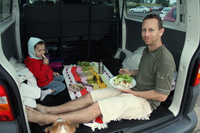Prairie Fare: Summer Adventures on the Road Call for Dashboard Dining
(Click the image below to view a high-resolution image that can be downloaded)
By Julie Garden-Robinson, Food and Nutrition Specialist
NDSU Extension Service
I remember 10 years ago when we took our three young children on our first family trip with the entire Robinson bunch. We drove to Utah and visited several parks along the way.
Looking back, we had a long drive with many “are we there yet” inquiries.
“We’re getting closer,” I would say.
“Do we have any snacks?” one of them would ask.
“Check the cooler or the snack box,” I’d respond.
With three children ages 9, 6 and 1, getting ready for a trip was a lot more work in our early family vacation days because we, as parents, had to do all the planning and packing. One-year-olds require a lot of equipment, so our vehicle was nearly full.
As we spent eight or more hours a day in the confines of a minivan, we could have been fodder for a reality show. “Meet the Robinsons” and “Vacation” already have been movie titles, though.
As it turned out, we weren’t quite the Griswold family of “Vacation” movie fame. We drove through wildlife parks and visited a zoo. By the end of the trip, my husband remarked that our van looked like animals lived in it, but no new pets had been picked up along the way.
This year, our now-19-year-old son decided he wanted to stay home and take care of our dogs. Imagine that. I kind of expected that watching movies his 11-year-old sister wants to watch in the confines of a van is not his idea of a good time.
Any time you leave the home routine, with its somewhat regular schedule and mealtimes, nutrition can be affected. With plenty of windshield time again this year, we will encounter fast food restaurants, convenience stores and hotel vending machines, with numerous food options to grab and go.
While healthful food options are available, many more tempting high-fat, high-sodium or highly sweetened options will tempt us. Convenience store items can stretch a family vacation budget, too.
Grocery stores have a much larger selection of food products, often at a more reasonable price. Milk might be the same price at either location, but foods, such as crackers or cookies, and paper products, such as towels and tissues, may be 1.5 to 2 times as expensive.
Taking a side trip to a grocery store when our rations run low was a good plan for us and provided a chance to stretch our legs.
Because we’ll be doing a bit of “dashboard dining” along the way again this year, I’m gathering snacks for my “van pantry.” I’m also trying to be conscious of the mess factors associated with eating in a vehicle. However, having older kids usually means fewer chances for some sticky upholstery and carpet.
We begin with an ice-filled cooler with 100 percent fruit juice, string cheese, tubes of yogurt, a package of baby carrots, low-fat deli meat (such as ham or turkey) and other perishables. We bring a thermos filled with ice water.
I pack a snack box with single-serving containers of applesauce and dried fruits, whole-grain crackers and single-serving cereal boxes. Packets of nuts and seeds are portable and nutritious snacks. Apples, bananas and grapes are other portable snacks for the road.
In our earlier days, plain tortillas with peanut butter were a kid favorite in our house. I was in charge of spreading peanut butter and rolling tortillas as we cruised down the highway.
Conscious of the mess factor, we always bring paper towels and moist towelettes for wiping our hands. Back in our early days, the windows and backs of seats also needed a wipe-down. In fact, packing a minivacuum would have been advised.
Here’s a snack mix that’s easy to make at home or on the road. If you don’t want to measure, just mix equal-size handfuls into a sealable plastic bag and shake gently.
Snack Mix
1 c. dry cereal (such as Chex or Cheerios)
1 c. peanuts
1 c. pretzel sticks
1 c. dried cranberries or raisins
Mix together and place in a recloseable plastic bag or in individual bags.
Makes eight servings. Each serving has 178 calories, 9.4 grams (g) of fat, 21 g of carbohydrate and 5 g of fiber.
(Julie Garden-Robinson, Ph.D., R.D., L.R.D., is a North Dakota State University Extension Service food and nutrition specialist and professor in the Department of Health, Nutrition and Exercise Sciences.)
NDSU Agriculture Communication – July 17, 2014
| Source: | Julie Garden-Robinson, (701) 231-7187, julie.garden-robinson@ndsu.edu |
|---|---|
| Editor: | Rich Mattern, (701) 231-6136, richard.mattern@ndsu.edu |


